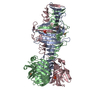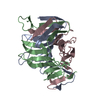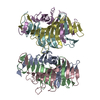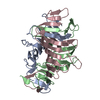[English] 日本語
 Yorodumi
Yorodumi- PDB-8ojn: Structure of the C-terminal beta helix domain of the Bdellovibrio... -
+ Open data
Open data
- Basic information
Basic information
| Entry | Database: PDB / ID: 8ojn | ||||||
|---|---|---|---|---|---|---|---|
| Title | Structure of the C-terminal beta helix domain of the Bdellovibrio bacteriovorus Bd3182 fibre | ||||||
 Components Components | Cell wall surface anchor family protein | ||||||
 Keywords Keywords | CELL ADHESION / Fibre / adhesin | ||||||
| Function / homology | Intramolecular chaperone auto-processing domain / Chaperone of endosialidase / Intramolecular chaperone auto-processing (ICA) domain profile. / Cell wall surface anchor family protein Function and homology information Function and homology information | ||||||
| Biological species |  Bdellovibrio bacteriovorus HD100 (bacteria) Bdellovibrio bacteriovorus HD100 (bacteria) | ||||||
| Method |  X-RAY DIFFRACTION / X-RAY DIFFRACTION /  SYNCHROTRON / SYNCHROTRON /  MOLECULAR REPLACEMENT / Resolution: 2.51 Å MOLECULAR REPLACEMENT / Resolution: 2.51 Å | ||||||
 Authors Authors | Caulton, S.G. / Lovering, A.L. | ||||||
| Funding support |  United Kingdom, 1items United Kingdom, 1items
| ||||||
 Citation Citation |  Journal: Nat Microbiol / Year: 2024 Journal: Nat Microbiol / Year: 2024Title: Bdellovibrio bacteriovorus uses chimeric fibre proteins to recognize and invade a broad range of bacterial hosts. Authors: Caulton, S.G. / Lambert, C. / Tyson, J. / Radford, P. / Al-Bayati, A. / Greenwood, S. / Banks, E.J. / Clark, C. / Till, R. / Pires, E. / Sockett, R.E. / Lovering, A.L. | ||||||
| History |
|
- Structure visualization
Structure visualization
| Structure viewer | Molecule:  Molmil Molmil Jmol/JSmol Jmol/JSmol |
|---|
- Downloads & links
Downloads & links
- Download
Download
| PDBx/mmCIF format |  8ojn.cif.gz 8ojn.cif.gz | 331.2 KB | Display |  PDBx/mmCIF format PDBx/mmCIF format |
|---|---|---|---|---|
| PDB format |  pdb8ojn.ent.gz pdb8ojn.ent.gz | 238.6 KB | Display |  PDB format PDB format |
| PDBx/mmJSON format |  8ojn.json.gz 8ojn.json.gz | Tree view |  PDBx/mmJSON format PDBx/mmJSON format | |
| Others |  Other downloads Other downloads |
-Validation report
| Arichive directory |  https://data.pdbj.org/pub/pdb/validation_reports/oj/8ojn https://data.pdbj.org/pub/pdb/validation_reports/oj/8ojn ftp://data.pdbj.org/pub/pdb/validation_reports/oj/8ojn ftp://data.pdbj.org/pub/pdb/validation_reports/oj/8ojn | HTTPS FTP |
|---|
-Related structure data
| Related structure data |  8ok3C  8oksC  8okwC  8ol4C  8omlC  8on4C  8onbC  8oncC  8ondC  8onfC C: citing same article ( |
|---|---|
| Similar structure data | Similarity search - Function & homology  F&H Search F&H Search |
- Links
Links
- Assembly
Assembly
| Deposited unit | 
| ||||||||||||
|---|---|---|---|---|---|---|---|---|---|---|---|---|---|
| 1 | 
| ||||||||||||
| 2 | 
| ||||||||||||
| Unit cell |
|
- Components
Components
| #1: Protein | Mass: 15519.053 Da / Num. of mol.: 6 Source method: isolated from a genetically manipulated source Source: (gene. exp.)  Bdellovibrio bacteriovorus HD100 (bacteria) Bdellovibrio bacteriovorus HD100 (bacteria)Gene: Bd3182 / Production host:  #2: Water | ChemComp-HOH / | |
|---|
-Experimental details
-Experiment
| Experiment | Method:  X-RAY DIFFRACTION / Number of used crystals: 1 X-RAY DIFFRACTION / Number of used crystals: 1 |
|---|
- Sample preparation
Sample preparation
| Crystal | Density Matthews: 2.3 Å3/Da / Density % sol: 46.62 % |
|---|---|
| Crystal grow | Temperature: 291.15 K / Method: vapor diffusion, sitting drop / pH: 6.5 Details: 0.03 M sodium nitrate, 0.03 M sodium phosphate dibasic, 0.03 M ammonium sulphate, 0.1 M imidazole/MES pH 6.5, 20 % v/v PEG 500 MME, 10 % w/v PEG 20000 |
-Data collection
| Diffraction | Mean temperature: 100 K / Serial crystal experiment: N |
|---|---|
| Diffraction source | Source:  SYNCHROTRON / Site: SYNCHROTRON / Site:  Diamond Diamond  / Beamline: I04 / Wavelength: 0.97 Å / Beamline: I04 / Wavelength: 0.97 Å |
| Detector | Type: DECTRIS PILATUS 6M-F / Detector: PIXEL / Date: Oct 13, 2019 |
| Radiation | Protocol: SINGLE WAVELENGTH / Monochromatic (M) / Laue (L): M / Scattering type: x-ray |
| Radiation wavelength | Wavelength: 0.97 Å / Relative weight: 1 |
| Reflection | Resolution: 2.173→92.968 Å / Num. obs: 39829 / % possible obs: 87.6 % / Redundancy: 6.3 % / Biso Wilson estimate: 48.12 Å2 / CC1/2: 0.994 / Net I/σ(I): 9.1 |
| Reflection shell | Resolution: 2.173→2.21 Å / Num. unique obs: 1511 / CC1/2: 0.349 / % possible all: 67.3 |
- Processing
Processing
| Software |
| ||||||||||||||||||||||||||||||||||||||||||||||||||||||||||||||||||||||
|---|---|---|---|---|---|---|---|---|---|---|---|---|---|---|---|---|---|---|---|---|---|---|---|---|---|---|---|---|---|---|---|---|---|---|---|---|---|---|---|---|---|---|---|---|---|---|---|---|---|---|---|---|---|---|---|---|---|---|---|---|---|---|---|---|---|---|---|---|---|---|---|
| Refinement | Method to determine structure:  MOLECULAR REPLACEMENT / Resolution: 2.51→92.58 Å / SU ML: 0.2979 / Cross valid method: FREE R-VALUE / σ(F): 1.34 / Phase error: 28.374 MOLECULAR REPLACEMENT / Resolution: 2.51→92.58 Å / SU ML: 0.2979 / Cross valid method: FREE R-VALUE / σ(F): 1.34 / Phase error: 28.374 Stereochemistry target values: GeoStd + Monomer Library + CDL v1.2
| ||||||||||||||||||||||||||||||||||||||||||||||||||||||||||||||||||||||
| Solvent computation | Shrinkage radii: 0.9 Å / VDW probe radii: 1.1 Å / Solvent model: FLAT BULK SOLVENT MODEL | ||||||||||||||||||||||||||||||||||||||||||||||||||||||||||||||||||||||
| Displacement parameters | Biso mean: 47.65 Å2 | ||||||||||||||||||||||||||||||||||||||||||||||||||||||||||||||||||||||
| Refinement step | Cycle: LAST / Resolution: 2.51→92.58 Å
| ||||||||||||||||||||||||||||||||||||||||||||||||||||||||||||||||||||||
| Refine LS restraints |
| ||||||||||||||||||||||||||||||||||||||||||||||||||||||||||||||||||||||
| LS refinement shell |
| ||||||||||||||||||||||||||||||||||||||||||||||||||||||||||||||||||||||
| Refinement TLS params. | Method: refined / Origin x: -22.6026858309 Å / Origin y: -1.98938795608 Å / Origin z: -24.4999411071 Å
| ||||||||||||||||||||||||||||||||||||||||||||||||||||||||||||||||||||||
| Refinement TLS group | Selection details: all |
 Movie
Movie Controller
Controller


 PDBj
PDBj
